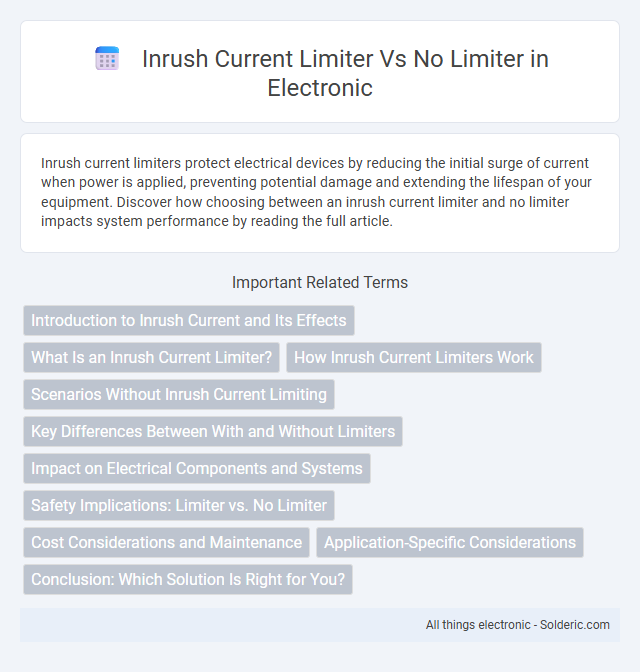Inrush current limiters protect electrical devices by reducing the initial surge of current when power is applied, preventing potential damage and extending the lifespan of your equipment. Discover how choosing between an inrush current limiter and no limiter impacts system performance by reading the full article.
Comparison Table
| Feature | Inrush Current Limiter | No Limiter |
|---|---|---|
| Purpose | Reduces initial surge current during power-up | No control over surge current |
| Component Stress | Minimizes stress on electrical components | Higher risk of damage due to high inrush current |
| Equipment Longevity | Extends lifespan of devices | Potentially reduces device life |
| Cost | Additional upfront cost for limiter | No extra cost |
| Energy Efficiency | Slight power loss during startup | No power loss related to limiter |
| Application | Critical in power supplies, transformers, motors | Suitable for circuits tolerant to surge currents |
Introduction to Inrush Current and Its Effects
Inrush current is the initial surge of electrical current experienced when powering on devices with capacitors, transformers, or motors, often reaching several times the normal operating current. This sudden spike can cause circuit breaker trips, component stress, and reduced equipment lifespan. Using an inrush current limiter protects your systems by controlling these surges, preventing damage and ensuring smoother startup performance compared to having no limiter.
What Is an Inrush Current Limiter?
An inrush current limiter is a device designed to restrict the initial surge of current when electrical equipment is powered on, protecting components from damage caused by sudden high currents. Without an inrush current limiter, electrical systems can experience excessive current spikes that lead to circuit breaker trips, component overheating, and reduced lifespan of equipment. Implementing an inrush current limiter enhances system reliability by controlling power surges and minimizing stress on electrical infrastructure.
How Inrush Current Limiters Work
Inrush current limiters reduce the initial surge of current when electrical devices are powered on by increasing resistance temporarily, safeguarding components from damage and extending equipment lifespan. These devices typically use thermistor technology, wherein the resistance decreases as the device heats up due to current flow, allowing normal operation current levels. Without an inrush current limiter, the sudden high current can cause circuit breaker trips, fuse blowouts, or irreversible component stress, emphasizing the critical role of limiters in electrical systems.
Scenarios Without Inrush Current Limiting
Scenarios without an inrush current limiter can lead to significant stress on electrical components due to sudden surges of high current at startup, potentially causing damage or reduced lifespan of devices like transformers and power supplies. Your system may experience voltage dips, circuit breaker trips, or fuse blows, compromising reliability and increasing maintenance costs. Implementing an inrush current limiter ensures controlled current flow, protecting sensitive equipment and maintaining operational stability during power-on events.
Key Differences Between With and Without Limiters
Inrush current limiters reduce the initial surge of current when electrical devices power on, protecting components from damage and extending lifespan compared to systems without limiters which experience high current spikes. Devices with limiters enhance system reliability by minimizing thermal and mechanical stress, whereas no-limiter setups risk sudden overloads leading to potential component failure and reduced efficiency. Limiter types like NTC thermistors quickly adjust resistance, providing scalable protection absent in direct, unrestricted current flows.
Impact on Electrical Components and Systems
Inrush current limiters reduce the sudden surge of current during device startup, protecting electrical components such as transformers, capacitors, and circuit breakers from thermal and mechanical stress, thereby extending their lifespan. Without a limiter, the high inrush current can cause voltage dips, nuisance tripping, and increased wear on components, leading to potential system failures and costly downtime. Implementing an inrush current limiter enhances overall system reliability and reduces maintenance expenses by smoothing the initial current surge.
Safety Implications: Limiter vs. No Limiter
Using an inrush current limiter significantly enhances safety by preventing sudden surges that can damage electrical components and reduce fire risk. Without a limiter, your system is exposed to high initial current spikes that can cause circuit breaker trips, premature equipment failure, and potential electrical hazards. Incorporating a limiter ensures controlled current flow, protecting both your devices and overall electrical safety.
Cost Considerations and Maintenance
Using an inrush current limiter can increase initial costs due to the added component and installation complexity but reduces long-term expenses by minimizing stress on electrical components and preventing premature failure. Without a limiter, upfront costs are lower, but maintenance expenses rise as equipment experiences higher wear and potential damage from frequent inrush currents. Implementing a limiter optimizes your system's reliability and lowers overall maintenance requirements, balancing cost considerations effectively.
Application-Specific Considerations
Inrush current limiters are crucial in applications with electronic devices sensitive to sudden power surges, such as transformers, motors, and power supplies, where they prevent damage and extend component lifespan. No limiter designs may be acceptable in low-power or robust systems where initial current spikes do not risk component failure or safety issues. Your choice should consider factors like equipment sensitivity, startup current magnitude, and the potential impact on system reliability and maintenance costs.
Conclusion: Which Solution Is Right for You?
Choosing between an inrush current limiter and no limiter depends on the specific application and electrical device sensitivity. Inrush current limiters protect equipment from sudden power spikes, extending device lifespan and reducing maintenance costs, especially in motors, transformers, and power supplies. If your system has high inrush currents or sensitive components, implementing a limiter is a cost-effective solution, while simpler, low inrush current setups may operate safely without one.
Inrush current limiter vs No limiter Infographic

 solderic.com
solderic.com